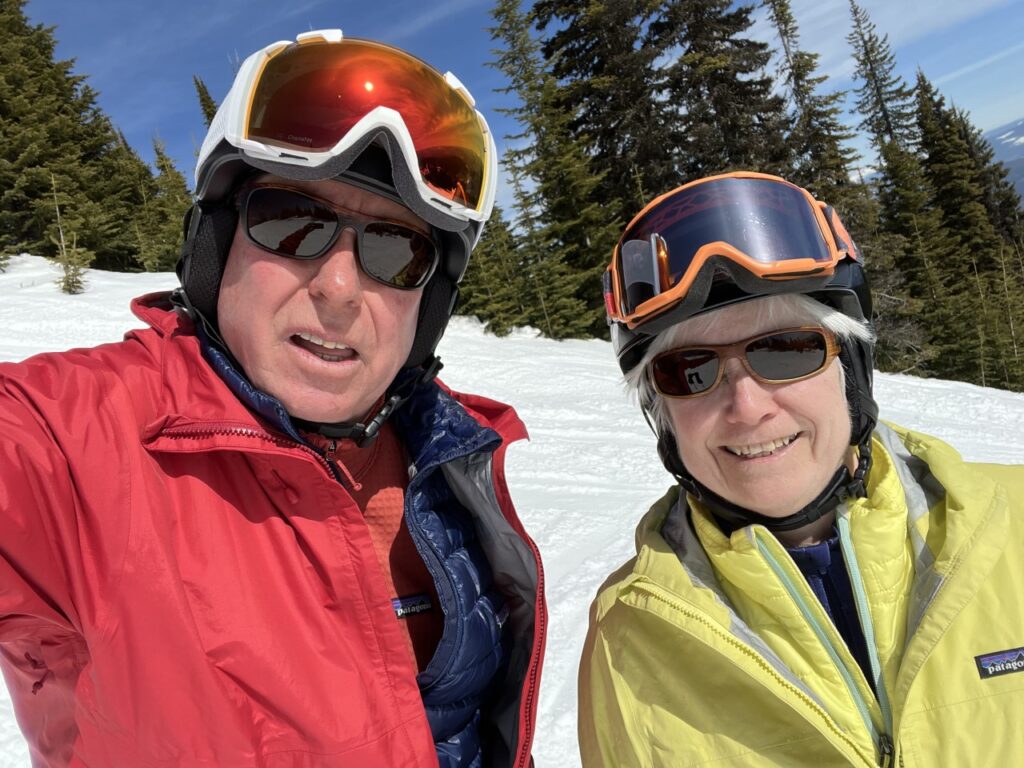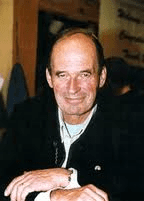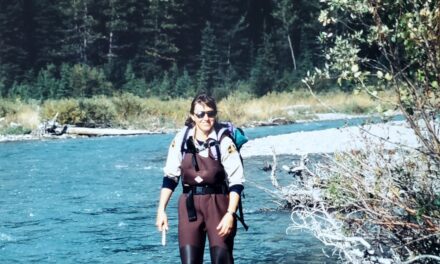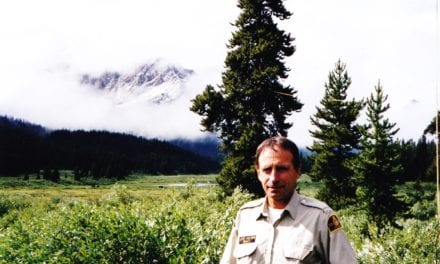This Oral History interview was funded in part by a research grant received in 2022 from the Government of Alberta through the Alberta Historical Resources Foundation.
Park Warden Service Alumni Society of Alberta
Oral History Project Phase 12 – Winter 2023
Telephone Interview with Ed Abbott
February 4, 2023–11:00 am MST
Kelowna and Invermere, BC
Interviewed by Susan Hairsine
SH: What was the place and date of your birth?
Ed: I was born in Hamilton Ontario on June 1952. I have four sisters; 3 of them older than me and one that is 8 years younger. I’m the only boy in the family, and the only one that went on to university as well.
SH: Where did you grow up?
Ed: Hamilton all of my life. We weren’t a wealthy family. I attended several different public schools. As you get older, you changed from a primary school to a secondary school. At the time in Ontario, we had Grade 13 so I went all the way to Grade 13 until I moved on to the University of Toronto in 1970.
SH: Was your family outdoorsy Ed?
Ed: Not particularly. My dad was a steel worker and worked three shifts and my mom was a stay-at-home mom. My older sisters all got married when I was 12. I had brothers in law that liked to go fishing so they would take me fishing north of the Toronto area, but I wouldn’t say we were outdoorsy.

Ed and Cheryl Abbott
SH: How did you become involved in the Warden Service? Which national park did you start working in?
Ed: I guess going way back, when I was in University of Toronto, I was taking my Bachelor of Science in Forestry. I met a fellow that was in my class; everybody probably knows him. His name was Ron Hamilton, and we became good buds through all of university. When he was away in the summers….everybody was supposed to try and take jobs that were related to fields in Forestry. Well Ron got a job through people that he knew, and his family knew, he got a job with Parks Canada and was working out west in Waterton and in Glacier on trail crew. We’d get together again every fall, when we’d been apart for our four or five months, trying to make money to pay for school, and he’d come back and tell me what his adventures had been over the summer working on trails and how he’d met the wardens and how the job seemed really interesting. It sounded pretty glorious to a kid that has grown up in Southern Ontario.
Part way through university he actually got to be a seasonal warden and would come back and start regaling the tales of working in places like Rogers Pass, which is where I started, in Glacier National Park. When we finished university, I reached out to Ron and asked if he could talk to somebody in Human Resources and was there any jobs out there?
Human resources called me back and said they had a job as an ELE-03 labourer, on the Highways department, and do you want a job. I said, “You bet” and I hopped in my 1970 Datsun and I drove all the way across the country in about four or five days, from Southern Ontario all the way to Rogers Pass and that’s how I got my foot in the door with Parks Canada.
SH: What year would that have been Ed?
Ed: That would have been the fall of 1974; that would have been my first stint. I did that for the winter. I shovelled snow and shared an apartment with Ron Hamilton, and when spring came, I started to apply for jobs like trail crew and the Warden Service. As luck would have it, I didn’t get one, so I was immediately unemployed come April. I had a term job so I moved back to Ontario for about eight months. Things didn’t pan out the way you would hope. I considered going back for my master’s degree but I really wasn’t interested in going back to school right away. So, I kind of bummed and waited til about January of 1976, so 8 months after I’d left, and I called Human Resources again in Glacier and I said, “You’ve got to have a job, I did a good one before, do you have anything?”
They said, “Yes, we actually have another ELE-3 term job. Do you want it?” I said, “Yes”. And they said “Can you get here in about a week?” And I said “Yes”, so I drove all the way back across the country again….
SH: In the winter
Ed: Yes, in the winter. I got the job in February 1976 and that was really when I got in. I worked until April and that spring I competed and got a full-time job as an ELE-3. So here I am still shovelling snow and I have my Science degree in Forestry. I’m hoping that I’m going to get a chance to get into the Warden Service. So, the next thing they offered me, because I guess I did a good job at shovelling, they said “Would you like to drive a truck instead, and plow snow?” So, I said “Yes I would. I’d like to make the extra money and who would want to keep shovelling snow?” They said, “Well we will train you and get you your truck drivers license, and your airbrake endorsement, and that’s what you can do for us.” I did that and it wasn’t until 1977 that I actually got offered a job in the Warden Service.
Back then things were very different at places like Glacier National Park. They didn’t have summer seasonal wardens. They had what they called student wardens. Seasonal wardens through the mountain parks were all PRC-08’s. That was the classification then. It switched over to GT’s later, but at the time they were all PRC-08’s. I was called a student warden and I think I was a PRC-04, but I had my foot in the door.
The man that interviewed me was Larry McGuire. He was the Chief Warden at the time. I think people called him ‘Haywire McGuire’ as his nickname. I remember him calling me into the office and interviewing me and then saying “Okay, you’ve got a job. And he said if you make a mistake, I’ll back you all the way to Ottawa but behind closed doors I’m going to kick your butt.” So I went “Okay I can work for a guy like this, he’s got my back and understands that you’re going to make mistakes, hopefully nothing serious but he’s going to let you know that you’ve made a mistake”.
You know Sue, I had to re-compete every year …. 1977, 1978, 1979 and I went back to the same jobs. I tried to get on the seasonal warden list for the summer jobs and I didn’t make it. Then in the summer of 1979 they had an opening for a seasonal warden job in Glacier in the wintertime. That was where they had seasonal jobs, in the winter. I got that job, so my first four or five years was back and forth between highway maintenance, student warden and then I got a seasonal warden in the winter. So that kind of got my foot in the door once again and I was learning a lot of the stuff that wardens do in the winter in Glacier National Park.
It went on and on. I don’t think many other wardens have had such convoluted ways of getting into the service. The next summer in 1980, I placed on a seasonal competition but I was far enough down the eligibility list that they offered me a term job. So, for the first time I went into the mountain parks in 1980. They offered me a 4-5 month term position in Lake Louise. It was very different. It was taking me out of an element that I had been in since 1976 in Rogers Pass into a place that everybody knew … Lake Louise, Banff, Jasper…they were the big parks, and they were where the action was. If you made it there you probably were going to do okay. But I got there, and Mike McKnight was the Area Manager in Lake Louise at the time and Andy Anderson was the Chief in Banff. When I got there, they said “Okay you seem to be a smart guy, you’ve got your degree so we’re going to assign you to Cliffy White to work on his Fire History Project that he’s got going for Banff National Park.” I said “Okay”.
I lived up in a house on Harry’s Hill that was empty and I shared it with one of the other wardens, and I worked for Cliff White that summer, going all over Banff Park, up the Cascade fire road, and lots of other places, doing his research work for the fire history in Banff. One of the caveats of the whole thing though was I had to meet Andy Anderson. Andy being the astute man that he was said, “I don’t want Ed doing just the fire stuff. You’ve got to give him some exposure to the other parts of the job. That’s what we are here to do, we are here to train him. You’ve got a job to get done Cliff, you’ve got your work to get done, but I want him to get exposed to some other stuff.” Fortunately he said that because that got me out on some climbs up on … I think it was still called Mount Eisenhower (now Castle Mountain) at the time, Brewers Buttress, and that sort of thing. I got a backcountry trip in the fall. All I remember was it was Dormer, but Cliffy and his father and myself , we went out for about 8 to 10 days and that was my trip out into the backcountry of Banff in 1980.
SH: Did you have horse experience Ed, at that point?
Ed: I had a bit. When I worked in Rogers Pass, Gordie Peyto was the warden down at east gate. He sort of looked after … that’s where the barn was and the horses were kept … so Gord got me out a few times in Glacier Park and we did some trips up into Copperstain so I had some familiarity. He showed me how to saddle a horse and how to throw a diamond and those sorts of things, so I had some experience but not very much. The terrain in Rogers Pass and through Glacier is far different than the terrain that you ride through in the backcountry in Banff.
SH: For sure. That’s where I started riding backcountry horses too.
Ed: You did? In Glacier? I didn’t know that. When I look back and when I was preparing for today’s interview, I thought “Wow, did I ever have a very circuitous route to get to where I finally got to at the beginning and I’m not complaining but it took me a long time to get to a point where I was a summer seasonal in Jasper and my career actually took some footing.
SH: So we are starting to running into “What different parks did you work in? So you’ve gone from Glacier to Lake Louise and then you went to Jasper.
Yes, I went back for one more winter in Glacier on my winter seasonal after my summer in Lake Louise. During that winter it seemed competitions were running it seemed every year. I got on a seasonal list, and they offered me a position in Jasper starting in the spring of 1981. At the time the Area Manager in Rogers Pass was a fellow called Bruce MacKinnon. A really good guy, and he had come from Jasper when he got the Area Manager’s job in Rogers Pass. He took me aside, and said, “If you want to go and get the most experience that you can, when they call you, say you want to go to Mile 45 or Poboktan warden station”, and I said, “Okay that sounds good.” and that’s what I did. They called me and offered me a job and I said if I can have my choice, I’d like to go to Mile 45 and work there. I think in Jasper they were pretty happy to have somebody that wanted to go to Mile 45 so that’s what I did.
Sometime in May I drove up to Jasper and checked in, and they showed me where I was going to live down at one of the houses at Mile 45. My boss was Al Stendie and the other seasonal in the little house at the front of the station was Al McDonald and his wife Bernadette, and the new GT-03, because everybody was in the GT category by now, but the new GT-03 coming to the station was Wes Bradford.
SH: That would be a fun gang.
Ed: Yes it was. I lived next door to Al Stendie and he really took me under his wing. It was a different style again. We had routine trips up to the Icefields area and Parkers Ridge, where we had study plots. We did weather readings, we did snow plots up there in the winter and we had horses at the station in the summer time. In wintertime we did freighting into the cabins with the double track skidoos and we would take supplies up to Brazeau Cabin and those sorts of things. It was a very diverse group and it was a lot of fun working there.
SH: Hey Ed, just a quick aside, how much caribou would you have seen back in those days?
Ed: I didn’t see them too much along the roadway, but you did see them occasionally. I do remember in the subsequent season in 1982, I was put in the Brazeau District, and I remember one trip I was coming back over the pass and I could see this huge herd, it looked like a huge herd, of caribou in Poboktan Pass. My pack horse that was behind me … I wasn’t trailing him, I was letting him walk behind me, and he was following me. But he saw these and must have thought they were a herd of horses. My packhorse ran across, over the meadows and joined the herd of caribou. Then he figured they weren’t the same as him, so he came high tailing back to join up with me on my saddlehorse. But you’d seen them up in Poboktan Pass and Jonas Shoulder area.
SH: Okay thanks, I was just curious about that. Sorry didn’t mean to interrupt you there. So, you went back to Lake Louise then?
Ed: No, my summer went on, it was a six-month seasonal, and the rumour always was you could get extended so as luck would have it I got extended on through the winter and I stayed at Mile 45 for a whole year. I gave up my seasonal winter job in Rogers Pass and gambled that Jasper was going to be my home for the next few years as I’d hoped. So, I did, I stayed and they extended me on that year and every subsequent year.
Don Dumpleton was the Chief of the day and I got to stay on with the guys at Mile 45 and I pretty much stayed there for a whole year. At the end of my first year, they tried to get all the seasonals out and get some backcountry experience. The next year, in 1982 they put me in the Brazeau District. I moved out of Mile 45 and I found private accommodation in Jasper because I knew I was going to come out of the bush, we were doing 17 days in and 4 days off, and I thought I’m going to come out of the bush after 17 days and the last place I’m going to want to end up sitting is Mile 45. So, I moved into town and I rented a bedroom off another person so I had a room to myself.
So I went out in the bush…my first trip was with Wes Bradford, who’d been the Brazeau District warden in the past so he knew it very well and Al Stendie assigned him to be sort of my supervisor. I remember it was June 21, 1982, that I went out on my inaugural trip with Wes, and he was going to show me the paths and the short cuts and everything through the Brazeau District. We got to Poboktan Pass and the horses were up to their bellies in snow. We were breaking trail through the pass to get down to the Brazeau Cabin. So that was a pretty long day getting out there. That was my first trip. He took me all the way through to Arete Cabin, Isaac Creek Cabin, Southesk, all the way to Cairn Pass which is where I had to turn around and come back. The other district warden would meet up at Cairn Pass. So he took me out for my first trip and I guess everything went okay. I packed the horses okay and didn’t have any major wrecks, and we came back. After that I was pretty much on my own out riding through the Brazeau District and along the boundaries of the Brazeau River.
SH: A pretty district. You were lucky.
Ed: Yes, it was nice. I could either go in through Sunwapta and go up over Poboktan or I’d go all the way down to Parkers Ridge and go in that way. It’s a little more trailering of your horses on start-up day. It was about an 18 mile ride in, so it was a fairly significant day in the saddle getting out. Then you could move up the line from cabin to cabin if you wanted or you could skip. It was a great summer, I learned a lot and didn’t see many people. It’s amazing … you kind of think of there being a lot of hikers out there but I would go days and days without seeing a soul and riding around. Evenings would be check in on the single sideband, check in with Dispatch if you could get through and then after that you would have the chit chat with the guys and gals, but mostly guys at that time, on the north boundary. You would chit chat at the end of the night.



